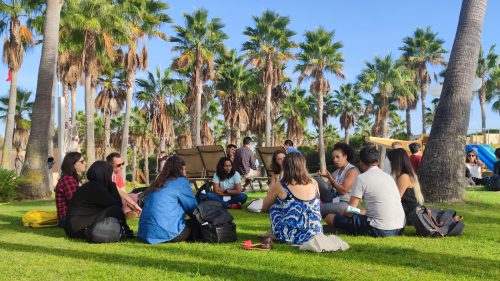Meeting report – 19th International Congress of Developmental Biology ISDB2021
Posted by Girish Kale, on 11 November 2022
by Girish Kale and Niveda Udaykumar
Girish Kale, Lemke lab, Centre for Organismal Studies (COS), Heidelberg University, Heidelberg. Germany
I guess I am speaking for everyone when I say that the ISDB 2021 conference was a much-needed source of serendipity. Although postponed by a year, the conference brought together an excellent line-up of speakers with four keynote lectures, a Harrison medal lecture, a closing plenary lecture, along with 10 scientific symposia; all centered on developmental biology. It was a feast!! Oh, did I mention the nearly 400 posters? This is where we test the limits of how much knowledge one can acquire in a short amount of time.
In my view, this meeting was a great amalgamation of what we are doing, as a scientific community, to get a global understanding of the journey of life, starting from a single cell to the formation of the entire organism. Speaking of single cells; it became abundantly clear that single cell -omics techniques, like ‘single cell RNAseq’, are becoming mainstream bread-and-butter for understanding developmental processes. Each of the symposia I managed to attend had at least one talk where the technique was used to test and/or construct scientific hypotheses. We were joking that anyone playing a drinking-game, having to drink every time ‘single cell RNAseq’ was mentioned, would be, at the very least, unsafe for driving.
In the past, I have been skeptical about the utility of in vitro experiments in developmental systems: I mean, why would you use an in vitro cell/tissue culture system to understand what’s happening in vivo? in vivo systems are so beautiful to begin with!! I would say, this meeting changed my mind. For one, that’s probably the only way we can experiment with rhinoceros; but more importantly, I got the impression that we, as a scientific community, are reaching a critical mass of research and researchers who know the in-and-out of modelling in vivo processes in vitro. With organoids, gastruloids, axioloids, segmentoids, intestinoids, etc. leading the way, the era of -oids is upon us, and one can only imagine the endless possibilities it presents.
Here I have to mention a couple of personal highlights. The location: it was my first time at the Atlantic Ocean (I know I am a bit lazy that way), and this was one thing I am sure everyone at the meeting enjoyed thoroughly. A short walk from the beaches was a nature reserve that hosted flamingos, along with plenty of other interesting fauna. Also, meeting the speakers was a great opportunity to learn how one can shape their thinking to be a great scientist, as well as become an interesting human being. Exchanging ideas, while sitting on the lawn by the pool, made this one of the best meet-the-speakers session I have experienced.
Of course, the most natural thing that happens at conferences happened here as well, meeting old colleagues and friends, and making new connection with peers, despite all the corona-worries. Also, I hope every foodie got the opportunity to try out the amazing fish food in restaurants around the conference venue. I guess the conference organizers had realized the importance of networking, and pushed us to arrange for dinner on three out of five conference evenings, giving us additional social and informal bonding opportunities.
If you are curious about the study involving rhinoceros, and many other unpublished data, we have also compiled a list of various preprints discussed during the ISDB2021 meeting. So, feel free to check our preList for the meeting as well.
Niveda Udaykumar, Indian Institute of Technology Kanpur (IITK), Kanpur. India
This year’s ISDB meeting was one filled with exciting opportunities to dive into the fascinating field of developmental biology. I was looking forward to this conference from the moment I submitted my abstract!
My experience at this conference was very fulfilling with scientific and personal realizations. I have very fond memories and experiences of this conference, which was my first solo international trip!
I liked several aspects of this conference, the first being the diverse speaker line-up, from the Harrison Medal lecture, the Keystone lectures, symposium speakers, and the oral presentations. The line-up of speakers catered to the scientific interests of most of the attendees, if not all! The talks ranged from trying to recapitulate human somitogenesis in vitro to evo-devo and metabolism. I was impressed with the poster session, with about 400 posters that showcased exciting ideas and hypotheses from all around the world.
Another great aspect was the ample time for the participants to interact with each other. This time was particularly useful as I got to discuss my research with several people, get feedback and talk about potential future positions with PIs. On some days, this time was spent catching up with old colleagues and friends. I appreciated the organizers’ efforts in the networking sessions, ‘Meet the Speakers’, where the participants could interact with any speaker of their choice. The parallel session of ‘Meet the Editors’ too well-received, where the Editors of prominent journals such as ‘Development’ and ‘Cells and Development’ interacted with the participants and familiarized them with their potential manuscript submissions.
Finally, I felt that the choice of location for the conference was perfect. We were privileged to have clear beautiful blue skies with sunny weather on most days, and the serene beaches of the Algarve were breathtaking. As an attendee of the conference, I know that I came back home refreshed and motivated, caught up with old friends, and made new friends, and I thank the organizers for their efforts in organizing such a fantastic conference.
Girish and I (read mostly Girish) have prepared a preList of the preprints that were mentioned in the ISDB conference. Please take a look at it, and if we have missed any, please don’t hesitate to contact either of us.



 (4 votes)
(4 votes)